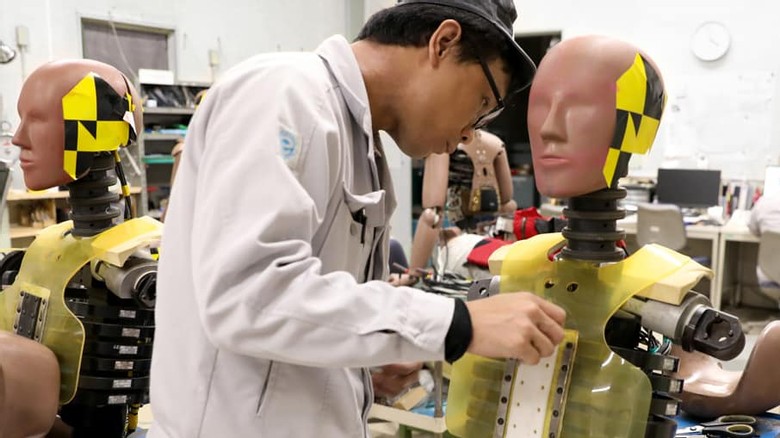INNOVATE
Mazda and the environment
Climate change is one of the most significant challenges the world has ever faced. And automakers are having to make changes fast to address it. But where do they start? Mazda has the all-electric MX-30 in its range, but with around two thirds of the world’s electricity generated by burning fossil fuels, the company recognises that it’s not as simple as creating a fleet of EVs.
That’s why Mazda is looking at the bigger picture. Its Life Cycle Assessment examines the company’s environmental impact in all areas of its operations in order to improve its carbon footprint – from energy sources to manufacturing to the end of life of its vehicles.
Mazda has set itself a target to reduce its well-to-wheel emissions by 90% by 20501
Mazda has been redesigning its technology from the ground up, reducing vehicle weight, and improving fuel efficiency, aerodynamics, safety and performance. It’s called Skyactiv Technology.
Under this umbrella, incredible world-first, award-winning engine technology has been developed: Skyactiv-D, Skyactiv-G and Skyactiv-X. All have reduced harmful emissions through better fuel economy and innovative engineering. This multi-solution approach ensures that no matter what a country’s energy policy is, Mazda can offer a powertrain that will reduce the environmental impact.
In addition, Mazda’s M Hybrid technology harnesses wasted energy created from braking. This energy is used to power the car’s electrical systems and assist the engine, improving fuel consumption and making for a smoother, more engaging driving experience.
The Skyactiv-X engine improves fuel efficiency by as much as 30%2
Research shows that reducing the weight of a vehicle by 10% can boost the fuel economy of that vehicle by as much as 8%3 – therefore fewer harmful emissions are released into the atmosphere.
From the main vehicle body shell, including fabricating and forging the thinnest body parts, to the smallest details, such as the wire that connects electric components, barely an inch has been left untouched in Mazda’s pursuit of reducing the weight of its vehicles.
Mazda’s bumpers are 20% lighter than previous incarnations thanks to a specially developed resin material4
Mazda’s innovative manufacturing techniques – such as mixed-vehicle assembly and production lines, and the ability to precision-cut multiple steel parts with one die – are also playing their part in reducing energy consumption and wasteful scrap.
Mazda has reduced direct landfill waste across the entire Mazda Group in Japan to 0.1% of total waste volume5
We all know plastic is one of the greatest sources of pollution on the planet. So Mazda has developed plant-derived bioplastics to build engine parts such as the radiator tank, as well as interior and exterior parts that can be dyed, removing the need for paints that emit harmful volatile organic compounds (VOCs) – chemicals released as gases by products or processes.
Mazda created the auto industry’s first high-strength, heat-resistant bioplastic and the world’s first plant-derived biofabric for seat upholstery
Where paint is required, Mazda’s Aqua-tech Paint System is another award-winning, world-first invention, with 78% fewer VOCs than the standard oil-based variety and a dramatic reduction in CO2 emissions.
Wherever possible, Mazda’s vehicles are made from recyclable materials such as aluminium. And to encourage vehicle recycling it is making sure each vehicle can be easily dismantled and components separated, to avoid cross contamination.
In Japan, Mazda’s plants and offices have reduced CO2 emissions by 47%6
Making a change takes time. But by examining the minutiae of its business, Mazda is showing it’s not just paying lip service to the climate crisis; it’s taking its role very seriously.
Mazda is making plans for the future, working with universities to research new fuels, such as algae biofuel, which cuts CO2 emissions when driving. It’s also introducing a small, lightweight rotary engine generator, which will be available in the Mazda MX-30 and will recharge the battery when it is low, increasing the vehicle’s driving range. There is even the possibility it could burn liquefied petroleum gas (LPG).
Mazda is committed to taking care of the Earth, people and society. All these innovations are being made to ensure the planet is respected, while taking nothing away from the pleasure Mazda drivers experience when they get out on the road.
Words Anna Muggeridge
1Reduce total global CO2 emissions from plants, offices and logistics operations as outlined in Mazda’s Sustainability Report 2019. 2Skyactiv-X engine fuel efficiency figures taken from Mazda article here. 3Weight reduction and fuel economy research conducted by the U.S. Department of Energy. 420% weight reduction of bumper as outlined on page 66, Mazda’s Sustainability Report 2019. 5Reduction of landfill waste across entire Mazda Group in Japan figures on page 73, Mazda’s Sustainability Report 2019. 647% CO2 emissions reductions in Mazda plants and offices since 1990 as outlined in Mazda’s Sustainability Report 2019.
find out more
Mazda’s green technology
Discover Mazda’s Skyactiv-powered vehicles




